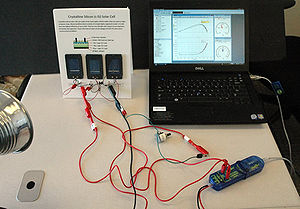Difference between revisions of "PV Characterization Lab"
Cmditradmin (talk | contribs) m |
Cmditradmin (talk | contribs) |
||
| (30 intermediate revisions by the same user not shown) | |||
| Line 1: | Line 1: | ||
<table id="toc" style="width: 100%"> | |||
<tr> | |||
<td style="text-align: center; width: 33%">[[Main_Page#K-12 Outreach Kits and Labs|K-12 Outreach Kits and Labs]]</td> | |||
</tr> | |||
</table> | |||
=== Overview === | |||
[[Image:Pvtest-computer.jpg|thumb|300px| ]] | |||
Solar cells produce different voltages and currents depending on the light levels and resistance in the circuit. How can you tell what the peak power of solar cell is? This is the method that researcher use to measure and compare the power from various solar cells. This is a good high school or introductory undergrad lab for physics or chemistry. It uses a simple technique with computer probeware to measure the current/voltage curve of a solar cell in order to determine its peak power. It allows you compare various types of cells and shows how difficult it is to get an accurate absolute measurement of performance. | |||
<br clear='all'> | |||
=== Procedure === | |||
<embed_document width="100%" height="600">http://depts.washington.edu/cmditr/mediawiki/images/a/a5/PV_Characterization_Lab.pdf</embed_document> | <embed_document width="100%" height="600">http://depts.washington.edu/cmditr/mediawiki/images/a/a5/PV_Characterization_Lab.pdf</embed_document> | ||
[http://depts.washington.edu/cmditr/mediawiki/images/a/a5/PV_Characterization_Lab.pdf | [http://depts.washington.edu/cmditr/mediawiki/images/a/a5/PV_Characterization_Lab.pdf Download the Lab PDF] | ||
[http://depts.washington.edu/cmditr/media/jvcurve.ds Datastudio file JVcurve- (right click and save as)] | |||
{{#ev:youtube|aVe4rRGq4p4}} | |||
=== External Links === | |||
*[http://www.nrel.gov/learning/re_photovoltaics.html NREL] | |||
*[http://www.ccmr.cornell.edu/education/modules/documents/PhotovoltaicCells.pdf Cornell PV modules] | |||
*[http://www.infinitepower.org/pdf/No19%2096-828B.pdf Estimating PV system size and cost] | |||
*[http://www.nrel.gov/midc/unlv/ live insolation data for Las Vegas] | |||
*[[wikipedia:Solar_cell]] | |||
*[http://www.powernaturally.org/Programs/SchoolPowerNaturally/InTheClassroom/kitlessons.asp Other Solar Lesson plans] | |||
*[http://zone.ni.com/devzone/cda/tut/p/id/7230 PV Characterization with LabView from National Instruments] | |||
=== Sources for materials === | |||
*[http://shop.pitsco.com/store/detail.aspx?CategoryID=69&by=9&ID=4426&c=1&t=0&l=0 $3.95 Pitsco amorphous silicon cell with clips.] | |||
*[http://search.digikey.com/scripts/DkSearch/dksus.dll?Detail&name=3590S-2-103L-ND 10K Ohm- 10 turn variable resistor] | |||
*[http://www.goldmine-elec-products.com/products.asp?dept=1174 Electronics Goldmine- A good source for solar cells.] | |||
*[http://www.pasco.com/prodCatalog/PS/PS-2100_usb-link/ Pasco PASPort USB link $59] | |||
*[http://www.pasco.com/prodCatalog/PS/PS-2115_pasport-voltage-current-sensor/index.cfm voltage/current probe $99] | |||
*[http://www.vernier.com/products/interfaces/lq-mini/ Vernier Lab Quest Mini (alternative to Pasco version) $149] | |||
*[http://www.vernier.com/products/sensors/ves-bta/ Energy sensor probe $69] | |||
Latest revision as of 09:58, 19 August 2014
| K-12 Outreach Kits and Labs |
Overview
Solar cells produce different voltages and currents depending on the light levels and resistance in the circuit. How can you tell what the peak power of solar cell is? This is the method that researcher use to measure and compare the power from various solar cells. This is a good high school or introductory undergrad lab for physics or chemistry. It uses a simple technique with computer probeware to measure the current/voltage curve of a solar cell in order to determine its peak power. It allows you compare various types of cells and shows how difficult it is to get an accurate absolute measurement of performance.
Procedure
<embed_document width="100%" height="600">http://depts.washington.edu/cmditr/mediawiki/images/a/a5/PV_Characterization_Lab.pdf</embed_document>
Datastudio file JVcurve- (right click and save as)
External Links
- NREL
- Cornell PV modules
- Estimating PV system size and cost
- live insolation data for Las Vegas
- wikipedia:Solar_cell
- Other Solar Lesson plans
- PV Characterization with LabView from National Instruments
